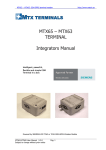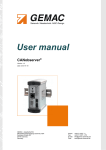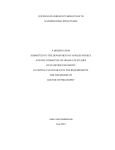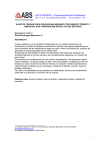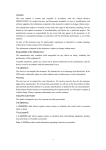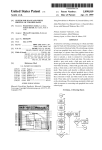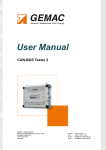Download Static disturbance signal recording system having detachable
Transcript
United States Patent 1191
[11] Patent Number:
Bouhelier et a1.
[45]
[54]
STATIC DISTURBANCE SIGNAL
4,356,475 10/1982 Neumann et a1.
340/521
“Comm SYSTEM "AVING
1'32???) 1511335 51" e‘ a" '
332%
TERMINAL
DETACHABLE
& PROGRAMMING m»
1222-22;
' '
512:: 12212511
5 ms ----------- -'
PART WITH SELEUHVELY POWERED
4:388:706 6/1983 Butler
BUFFER MEMORY
.
-
~
.
-
[75] Inventors‘ its”; gzngelggngiaude vmhme’
Nov. 12, 1985
“
4,398,272
8/1983
Sibert ........... ..
4,399,513
8/1983
Sullivan et a1.
4,430,653
Thomson CSF, Paris, France
2/1984
237533
:1 365/226
367/33
.. 364/551
.. 364/415
Coon et al. .................... .. 343/5 NA
OTHER PUBLICATIONS
[2'] Appl' NO‘: 395’313
[22] Filed:
Jul. 6, 1982
[30]
Foreign Application Priority Data
Jul. 17, 1981 [FR]
Date of Patent:
4,417,306 ll/1983 Citron et a1.
'
[73] Asslgneez
4,553,223
R. Allen, Microcomputer Assistance in Clinical Monitor
ing oflmracranial Pressure, Medical & Biological Engi
neermg 8:. Computing (May 1981) pp. 349-355.
Primary Examiner—Raulfe B. Zache
France .............................. .. 81 13977
[51]
Int. Cl.‘ ...................... .. G06F 3/00; G06F 11/30;
[52]
us. c1. .................................. .. 364/900; 364/420;
Assistant Examiner_Archie E. Williams, Jr.
Attorney, Agent. or Firm-Cushman, Darby & Cushman
G06F 15/16; G06F 15/20
364/200 MS File, 900 MS File,
[57]
ABSTRACI
The system includes a basic recorder module where a
delay element is followed by a solid state buffer mem
364/571, 415, 417, 420-422, 550, 551, 518;
324/51, 113,111, 112; 128/709, 710
References Cited
ory, digital interface circuits for transferring the re
corded data, processing means, a printer and/or mag
netic memory unit, a detachable programming terminal
for the dialogue with the recorder and its programming,
364/422; 364/518; 364/551; 324/113; 324/111
[58]
Field of Search
[56]
U.S. PATENT DOCUMENTS
as well as a separate power supply for the working part,
Re, 31,222
4/1983
McCracken ....................... .. 364/571
4,161,782
4,216,462
4,350,979
7/1979
8/1980
9/1982
McCracken ...... ..
364/571
McGrath et a1. .... ..
.. 340/150
Eberwcin .......................... .. 340/861
.m...
1111
so that the latter is only supplied in the recording mode
or during a connection of the programming terminal.
10 Claims, 6 Drawing Figures
mm‘
5,
s5
4 m...‘ 531
m!
r1
.42."
56
l
In,
'
52w E'XL cnnsuuumr
51
“mm.”
l
_
IEPT My“
not,"
"a"
A“! lid on
I
l
7
6
I —"_,—’F 123:2?’"11
wruneu
EL
'
gTP
US. Patent
Nov. 12,1985
5E}
‘
: .
51
Sheetlof3 ~ 4,553,223
-
FIGJI
“
:PJ’ BYL
o
r
'
O
‘
I
WATCH-LNG
1
PART
1? MATcHnflG
I
,
1 0
,
‘
S
J 11
12
i,
_ MULTIPLEXER
Bm
‘
‘
f3
2212222205
Q
_‘ ‘W
'\ 51
,
4 Xmzmesenme 5
msnonv
j
v5 5
10 A
71 TIME oxrms ‘ J 59
oevrcz
S >
sex
5 2m
6''\_
7
ACCUMUL?
10
10-”) 1
CENTRAL UNIT
pnoanAmagg MEMORY
EPV
I
{-EP }
POWER
SUPPLY
4
+ +
5'1!
1
BUFFER
MEMO"
‘R
ROM
‘"
POWER
‘_
SUPPLY
13>
1D
AUX. SIG. GEN.
8]
}
!
EX
1'; 5T
a
n
m N6
{rig-Email.‘ /
GEN.
PART
1
ssmss
D U D D
_..
INTERFACE
223 £———-;
KEYBOARD
Pnocsssms
wonxme
I
CHARACTER
307
AUTO‘
i
.
}
M
w
INTERFACES
POWER
SUPPLY
20
Z 25
CENYRAL
UNIT
DISPLAY
'3 U D c‘
25>
L21
£24
U. S. Patent Nov. 12, 1985
FI'G_E
Pie. 2
FROG MMMM ING
TERM INAL. l l l
r-
|
'
v
.
_ DISTURBANCE
RECORDER
PAPER
PR|NTER.UN|T
4,553,223
Sheet 2 of 3
L11 H l
,4 EP1
2P2
EXTERNA
CLOCK
CONNE CTION
BOX
ill
i
Hi
EFZ
EP4
BL
P - - - '-'—|
|
i
I
UNM
_____1.
F”_"L'""l
|
IP
I
L_______l
U.S. Patent Nov. 12, 1985
Sheet30f3
4,553,223
4027
SHIFT
REGISTER
FULL
SCRUTINY
4057
4137
scnurmv
_ _ __ ’
SCRUTINY
omzrmmow
AUTO-TEST
READ
4042
1147
CONTROL
422
omzn'rms
N0
INTO
'
’
CALCULATIONS‘
MASS
MEMORY
YES
415
7
FINISHED
YES
H5
‘No
__.____’
424
P2315315“
EQUIPMEN
YES
TRANSFER To
PERIPHERAL
EQUIPMENT
-——-———’
H5
OPERATOR
DIALOGUE
1
4,553,223
STATIC DISTURBANCE SIGNAL RECORDING
SYSTEM HAVING DETACHABLE
PROGRAMMING TERMINAL &
PROGRAMMABLE FIXED PART WITH
SELECTIVELY POWERED BUFFER MEMORY
2
memory and the digital-analog conversion circuits pre
ceding a recorder on paper. The capacity of the disk
memory is equivalent to several rolls of paper. Thus, the
size of this memory makes it possible to considerably
reduce the frequency with which the rolls of paper are
replaced. If the writing or recording device is detach
able, the operator can transport it with him and repro.
duce on the paper the recordings of the day of his or her
BACKGROUND OF THE INVENTION
visit.
The present invention relates to disturbance signal
The disadvantages of this latter electronic solution
recorders, also called fault recorders. These devices 0
are mainly in the type of memory used, the latter form
have two characteristic operating modes, namely a
ing an integral part of the recording chain. For certain
watching mode during which only electrical input sig
applications, such as the monitoring of electric power
nals are monitored, and a recording mode during which
transmission lines in tropical countries, the characteris
the electrical input signals are effectively recorded. The
start of recording is generally a few tenths of a second
before the appearance of the disturbance or trouble in
order to subsequently make it possible to obtain details
5 tics of the flexible disks (temperature range for use 5“ to
45° C., permitted relative humidity 20 to 80%) may
prove inadequate. Moreover, a breakdown in the ?exi
of the complete history thereof.
ble disk memory automatically leads to a failure of the
There are two main types of disturbance signal re
recorder which, from then on, is no longer able to col
corders, namely electromechanical and electronic re 20 lect new information.
corders, but the present invention relates to the latter
type.
According to a ?rst known embodiment falling in this
category, an electronic device producing a time lag or
BRIEF SUMMARY OF THE INVENTION
One object of the present invention is to provide a
disturbance signal recorder system eliminating the dis
delay is inserted upstream of the device for writing on 25 advantages of the preceding solutions, while offering
paper, which uses optical galvanometers, a halogen
the advantages of each of them. In particular the system
lamp and a photosensitive paper. For this purpose elec
uses a buffer memory having a relatively large capacity,
trical input signals. after undergoing analog-digital con
version, pass through the delay device or pretriggering
which can work in combination with an economic writ
ing or recording device permitting both alphanumeric
memory or store formed with the aid of a shift register 30 entries (dating and identification) and graphic entries on
a paper which is stable before and after use.
tion to the galvanometers. This solution has a number of
and are then reconvened into analog signals for applica
disadvantages due essentially to the writing devices
used. Galvanometers with halogen lamps are expensive
and the fact that they are constantly supplied with
power is prejudicial to their reliability. In addition, the
need to periodically replace the roll of paper used leads
to high operating costs. Finally, the photosensitive
As can be gathered from the following description,
the system also provides speci?c advantages, the most
important being programmability of characteristics,
easy remote transmission of data and comparibility with
automatic analysis and digital processing means, great
?exibility permitting combinations with high-perfor
mance peripheral modules, high reliability due to the
paper of the writing or recording device has a poor
40 use of static components and low electric power con
storage life, both before and after use.
sumption when operating in the watching mode.
According to a second known solution, certain of
The present invention therefore provides a distur
these disadvantages are obviated by using a conven
bance signal recorder system comprising a fixed part,
tional writing or recording device having styli, so that
called the disturbance signal recorder installed at a
costs are reduced and the paper has a good life. How
ever, the stylus recorder has a reduced pass band of 45 recording point and set up so as to receive electric sig
nals to be monitored and record disturbance, a separate
approximately 30 Hz at the most and for reproducing
complementary part comprising recorded data process
signals with a higher frequency a device is provided for
ing means, and electrical connection means between the
slowing down the signals to make them compatible with
two parts, the interfering signal recorder comprising,
the stylus recorder. This device is constituted by a solid
connected in series, means for the reception and match
state electronic memory, which is inserted between the
shift register, i.e. the pretriggering memory, and digital
analog reconversion circuits. A disadvantage of the
stylus recording device is the difficulty of reproducing
in a simple manner and at the same time as the input
signals, the date information necessary for processing
the recordings.
ing of electrical input signals, analog-digital conversion
and multiplexing means, a first or so-called pretrigger
ing memory for producing a delay and a second mem
ory for recording disturbance. the recorder also com
prising means for the detection of disturbance supplied
by the reception and matching means, a time dating
In addition, these two solutions have two important
de?ciencies. The ?rst is the need of systematically re
placing the roll of paper and the second is the lack of
flexibility of the information support, a diagram on
device, control and management means having a central
paper not really being suitable for automatic analysis
wherein the second memory is a semiconductor buffer
and digital processing without the use of a human oper
memory having a predetermined capacity for a storage
of data to be subsequently transmitted to the processing
ator.
unit for checking the conversion and multiplexing
means and for controlling the recording in the second
memory, and auxiliary signal generator circuits,
part, said disturbance signal recorder also incorporating
A third solution obviating the aforementioned dif?~
culties is described in French Patent Application 65 separate supply means for supplying the buffer memory
2,429,998. The useful input signals are recorded on a
and the auxiliary signal generator solely when distur
?exible disk magnetic memory inserted between the
bance or trouble is occurring, dialogue and program
ming means in the form of a detachable device, digital
shift register constituting the so-called pretriggering
3
4,553,223
interface circuits constituting the said connection means
between on the one hand the recorder and the process
ing means and between on the other the recorder and
the dialog and programming device.
BRIEF DESCRIPTION OF THE DRAWINGS
The invention is described in greater detail hereinaf
ter relative to non-limitative embodiments and the at
tached drawings, wherein show:
FIG. 1 a block diagram of an disturbance signal re
corder system according to the invention.
FIG. 2 a diagram of a ?rst modular embodiment
corresponding to the system of FIG. 1.
FIG. 3 a diagram of a second modular embodiment
which includes several ?xed stations connected to a
single exploitation unit.
FIG. 4 a diagram of a third modular embodiment as
in FIG. 2 and which utilizes a peripheral magnetic
memory.
FIG. 5 a diagram of a fourth modular embodiment as
in FIG. 4 and which utilizes a peripheral magnetic
memory.
FIG. 6 a ?owchart of a system according to the in
vention.
DETAILED DESCRIPTION OF THE
PREFERRED EMBODIMENTS
A disturbance signal trouble recorder system accord
ing to the invention comprises several assemblies or
modules. These can be subdivided into a first part in
stalled as a ?xed station at a recording point and which
constitutes the basic module or disturbance signal re
4
well as to the detection circuits 3. The digital signals are
received at terminals B'1 to B'm.
In the case of analog signals, the detection circuits 3
operate by threshold comparisons, ?ltering or other
procedures for the purpose of detecting specific disturb
ances, which can be in the form of an amplitude varia
tion, a frequency variation or a variation of some other
characteristic parameter of the corresponding input
signal. In the case of digital signals, the detection of
O interference is based on the detection of the changed
state of one or more inputs.
The multiplexing output S1 is transmitted to a pre
triggering memory 4 of the shift register type to intro
duce a given delay which makes it possible, during the
detection of interference by circuit 3, to record in a
downstream circuit the position prior to the disturbance
for a given time which is essentially equivalent to the
said delay, e.g. of approximately a few tenths of a sec
ond. Memory 4 is connected by its output S2 to a sec
ond memory 5 for recording disturbance.
A circuit 6 processes the control and synchronization
signals S3 relative to conversion and multiplexing cir
cuits 2. By link S4 it controls the recording of disturb
ances and to this end one output S5 of circuit 3 is trans
25 mitted to circuit 6 across a time dating device 7.
The time dating device 7 serves to supply a very
precise dating, e.g. to within one thousandth ofa second
for each disturbance signal or the like. This information.
as well as the date, is transmitted by link 56 to circuit 6
to be recorded in the second memory 5 at the head of
each recording in the form of an identifier containing in
digital form all the information for the subsequent pro
cessing of the data, namely the characteristics of the
corder EP, whose function is to monitor the electric
position and apparatus where the recording was carried
input signals and record possible disturbance in a solid
state memory forming a buffer. There is also a second 35 out, together with the date and duration thereof.
Time dating device 7 uses circuits having a low elec
partex, which can be installed in the vicinity of recorder
trical power consumption, e.g. of C/MOS technology.
EP or at a distance therefrom. The second part may be
An accumulator 10A permanently charged by power
built in accordance with a centralized processing device
supply 10 is used as an emergency supply for time dat
for use by several interfering signal recorders EP. This
second part EX can be constructed in various ways and
essentially comprises means for processing data re
corded in module EP. Processing part EX can be real
ized by means of a paper printer IP or can incorporate
a memory unit UM, as will be shown hereinafter.
ing device 7 via link S10 in the case of a temporary
interruption of the general power supply 10. Link S11
connects the time dating device to the outside to enable
it to receive or transmit synchronizing signals. The
latter can come from an external clock HX (FIG. 3) or
In FIG. 1 the disturbance signal recorder system is 45 some other recorder EP (FIG. 5) and can be passed to
represented by its essential components, namely the
actual recorder EP, the processing circuits EX and a
programming terminal TP. The original construction of
recorder EP ensures the high degree of ?exibility of the
system.
one of several other recorders EP.
Circuit 6 comprises a central unit and associated cir
cuits 2 for forming a microprocessor or microcomputer.
Therefore it is also provided with variable input and
Recorder EP incorporates connection means for the
program memories, constant data memories and bus
links with the input/output circuits. Its structure is of a
reception of input signals to be monitored. Connection
conventional nature and reference can be made in this
connection e.g. to the document published by the MO
TOROLA company entitled: “M 6800 Microcomputer
n input signals SE1 to SEn. The input terminals are
connected to a group of matching circuits 1, which are 55 System Design Data".
Central unit 6 controls the writing into memory 5 and
connected to the channels for which matching is pro
takes place on terminals B1 to En able to receive up to
vided (matching of level, pass band, etc.).
The signals leaving unit 1 are transmitted on the one
hand to analog/digital conversion and multiplexing
circuits 2 and on the other to disturbance signal detec
tion circuits 3.
The conversion into digital form of the signals re
ceived in analog form can be carried out before or after
multiplexing. In the latter case it is merely necessary to
subsequently the reading of the memory for transmit
ting the data to the processing means across interface
circuits 8.
Thus, a first feature ofthe system results from the fact
that the external links of recorder EP take place by
digital interface circuits. There is no digital-analog re
conversion at the output of the second memory. The
connection between recorder EP and processing means
have a single conversion circuit, but the reliability of 65 EX can be in the form of a standard digital link, e.g. of
the RS232 type. This arrangement. which renders su
the system is better with the ?rst option. Obviously the
system can also receive signals in digital form, which
are directly transmitted to the multiplexing circuits 2, as
per?uous a demultiplexing operation and a digital
analog reconversion operation, also has the advantage
5
4,553,223
6
lator and which can therefore be easily transported. In
the same recorder EP, terminal TP comprises a central
of "scratching" the output signals, thus making it possi
ble to connect numerous ancillary devices particularly
of the informatics type to the recorder EP.
unit 21 whose programmes can evolve. It is connected
to digital interface links at 8 and makes it possible to
The disturbance signal recorder EP also comprises in
per se known manner, so-called auxiliary circuits 9 for
produce all the controls and programming, while per
processing service signals indicating e.g. by the closing
mitting a dialogue between the operator and the re
corder EP as a result of the alphanumeric display on
of a relay contact that recording is taking place or for
controlling the making live of the ancillary equipment
terminal TP. Thus, the interfering signal recorder EP
for receiving the data. These service signals are trans
mitted to the outside in digital form across interface
circuits 8.
A second feature of the recorder is that solid state
memory 5 is a static memory instead of being dynomic
can be designed with a box or case having substantially
no manual controls on the front face, which makes it
possible to greatly cut down costs. The dialogue and
programming by the bias ofterminal TP are made possi
ble as a result of central unit 6 which. in the read-only
memory 13 programmed for this purpose, can convert
such as a disk or tape memory. Semiconductor memory
5 has an average capacity which can be e.g. about 10
seconds of recording. In fact it forms a buffer memory
between the recorder and the external analysis and
processing means EX.
According to a third feature of the system, recorder
EP is subdivided into two parts, namely a constantly
5
the dialogue of the informatics type into dialogue which
can be easily interpreted by a not specially trained oper
ator. The ROM 13 is the equivalent of a dictionary and
can be changed when the language of the operator
changes. For information purposes it is pointed out that
the essential components of programming terminal TP
supplied watching part EPV and a working part EPT,
which only receives power in the recording mode. In
are a series interface 20, central unit 21, a character
actual fact part of EPT is also supplied when recorder
EP is used with programming terminal TP, in the man
ner described hereinafter. This is brought about by
means of separate supplies for each of the parts, power
supply 10 relating to the watching part and rendering
a power supply 25, which is controlled from power
supply 11, which is started up by closing contact door
12. The latter can also be brought into the closed posi
tion by the mechanical locking or engagement of the
generator 22, keyboard 23 and a display 24, apart from
connection of the programming terminal.
live the circuits involved in this part as soon as the
The disturbance signal recorder EP can be combined
recorder is started up. The second power supply 11
with a printer IP constituting the processing circuits
relating to the working part EPT is only triggered by
30 EX, so as to reproduce on paper the elements stored in
output S7 of detector 3 during the detection of interfer
ence in order to render live the circuits of the working
buffer 5. As shown in FIG. 2, printer I? can be of any
random type, provided that it can operate both in the
part. Following a corresponding recording through the
graphic mode for plotting curves and in the alphanu
meric mode for entering data and other data and pro
buffer memory 5 the central unit, via link S8, controls
the stopping of the power supply of the working part by
circuit 11. However, a manual control 12 makes it possi~
ble for the working part EPT to be made live by the
35
vided that it can be remotely started up (Le. made live
by control of recorder EP). Thus, it is possible to use a
thermal, electrosensitive, optical fibre cathode ray tube
or laser printer which the user can choose as a function
operator during the use of the programming terminal
of requirements. The arrangement does not suffer from
TP. Working part EPT incorporates the second or
buffer memory 5, auxiliary circuits 9, interface circuits 40 the disadvantage of loss of monitoring in the case of the
paper ending or the printer failing. Thus, memory 5
8, as well as a programmed read-only memory 13,
generally has an adequate capacity to be able to await
which is used by the bias of the central unit 6 during
the arrival of the operator, while being ready to store
dialogue with recorder E? by means of programming
any other possible recordings. Programming terminal
terminal TP. It should also be noted that central unit 6
can form part of the working part EPT by means of the 45 TP is shown in dotted line form, because it is normally
transported by the operator and is not involved in the
use of a second central unit in the watching part ensur
normal operation of the recorder.
ing the control links S3 to the conversion and multiplex
FIG. 3 shows a variant of the preceding combination
ing circuits 2 and S9 to the detector circuits 3. Link S9
in which several disturbance recorders EPl, EP2, etc.
makes it possible for central unit 6 to interrogate circuit
3 in order to obtain information on the origin of the 50 are combined with a single printer I!’ by the bias of a
connection box BL serving as a multiplexing circuit, in
triggering process and can then place this information in
such a way that dialogue is successively possible with
the identi?er at the head of the recording.
the different recorders EPl, EP2, etc. connected by
When a second central unit or a small microprocessor
their synchronizing inputs/outputs to an external clock
is used, said second unit is obviously connected to the
55 HX.
central unit located in the working part.
As a result of the subdivision of recorder E? into two
The constructions according to FIGS. 2 or 3 involve
an operator moving or replacing the roll of paper. This
separate and entirely static parts, whereof only the
watching part is constantly live, the average absorbed
part is greatly reduced and reliability is high. For infor
can be disadvantageous when movements are restricted,
so that recorder EP according to FIG. 4 or recorders
mation, the power can be below 20 Watts.
EPl, EP2, etc. according to FIG. 5 are connected
(across a connecting circuit BL in the latter option) to a
A fourth feature of the system is the possibility of
magnetic memory or store, whose capacity can be very
programming certain of its characteristics, such as the
high, e.g. several thousand seconds. This amounts to
pass band, the sensitivity, the duration of the record
introducing a third memory in the data chain, namely
ings, and the service identi?cations, which makes it
possible to use it for developing the recordings accord 65 unit UMM, whose capacity is much higher than that of
buffer memory 5. The user is able to choose the most
ing to the particular needs. This results from the use of
suitable magnetic memory unit for his requirements, as
a conventional programming terminal TP constituted
a function of the sought capacity and the environmental
by a portable terminal having the size ofa pocket calcu
7
4,553,223
conditions. This is obviously particularly advantageous
in the case of remote connection concepts, when the
management of one or, in general, several interfering
8
nals by multiplexer at 2 on periodic control by signal S3.
The following operation 103 is the orientation of the
digital result S1 of the scrutinization into the pretrigger
signal recorders is centralized. In this case it is neces
sary to combine with recorder E? a supplementary
interface component adapted to the remote connection
ing memory 4. The digital data are entered in memory
4 in place of the oldest data previously there. The oldest
mode (telephone lines, high voltage lines, optical ?bres,
buffer memory 5, as will be shown hereinafter during
radio links, etc.), whereby this component can be e.g. a
modulator-demodulator in the case of a telephone link.
Units UMM can be of the flexible disk or magnetic tape
type, said two supports being detachable, or it is also
possible to use memory units of the ?xed disk, magnetic
bubble or other types. In each of these cases the opera
tor can program recorder EP in such a way that when
the memory support is full in magnetic memory unit
UMM, it erases the oldest recordings and replaces them
by more recent recordings.
data are then either eliminated, or transmitted to the
the analysis of the diagram EFT. Stage 104 corresponds
to control calculations performed by the central unit for
making the sampling frequency dependent on the fluc
tuations of the signal frequency to be checked, in such a
way that substantially the same samples of the consid
ered signal are selected during the successive cycles
thereof. This operation makes it possible to prepare the
sampled signals for subsequent processing by compres
sion reserved for the signals resulting from interference
and therefore, said processing is only performed in
working part EPT. Operation 104 results from the pro
In the arrangements of FIGS. 4 or 5, which use a
gramming of central unit 6. The result of the control
magnetic memory unit UMM, a printer IP is indicated
by dotted lines and it is possible to reproduce on the 20 calculations influences the sampling frequency given by
latter the recording when this is desired by the operator.
control signal S3.
The central diagram relates to the test and operations
of the working part EPT. Initialization in 110 is con
trolled by signal S7 which releases power supply 11.
the operator transfers data from the magnetic memory 25 Stage 111 represents the recording cause test, which
can result from disturbance detection (to 112) or an
unit UMM to printer IP. In the described arrangements
Printer 1? can be carried to the location by the operator
at the same time as terminal TP. By means of the central
unit 6 of recorder EP or one of them (case of FIG. 5),
incorporating one or more recorders EP, it should be
noted that decisions are centralized by the recorder and
auto-test control (to 121) or an operator dialogue re
not by the associated peripheral equipment. As by defi
quest (to 125). [n the case of disturbance detection, the
corresponding signal is S6 received by central unit 6.
nition disturbance is of a random nature, it can intervene
during a dialogue or a data transmission. The central
Stage 112 is the test controlled by unit 6 of the state of
memory 4, whether or not the latter is full. If it is not
full, ?lling continues. If it is full, operation 113 consist
ing of reading the oldest data stored in 4 takes place.
Stage 114 is the operation of orienting said data (after
interrupts the link between the recorder and its periph
35 processing by possible compression) into mass memory
eral equipment when this is necessary.
unit 6 is programmed in such a way that the recording
function has an absolute priority and the central unit
It should also be noted that a test of satisfactory oper
ation can be required by central unit 6 of recorder EP in
connection with the peripheral equipment before or
after each use or in a periodic manner, in order to check
5. Test 115 corresponds to the end of recording in mem
ory 5, i.e. the end of the disturbance to be recorded. It
is possible here to have several different operating types
and, for each of them, a predetermined recording time
as a function of the preprogrammed rules. Test 116
corresponds to a programmed output to a peripheral
that the system is ready to operate. This test is received
by the recorder in the form of a digital state word and
is analyzed by central unit 6 and can lead to the operator
being called, when a fault is detected. This call takes
device and stage 117, in the affirmative, to the transfer
operation to a magnetic memory unit UMM or external
place by means of auxiliary circuits 9. The operator then
printer IP. Stage 118 is the end of recording.
has access to the state word characterizing the fault by 45
The right-hand diagram shows at 120 the test cause of
the initialization of the EFT in the absence of distur
using programming terminal TP. For information pur
bance. Stage 121 represents the auto-test operation
triggered by circuit 30 ofthe processing part. It can also
represent a periodic test and automatic operation, pro
test on interrogation of the central unit 6. Circuits 30 50 grammed by central unit 6 and initiated by a signal from
poses auto-test circuits 30 are shown in the processing
part of FIG. 1, said circuits serving to supply the digital
state word corresponding to the satisfactory operation
liminary OEM Manual for a Floppy disk controller
the time dating device 7. Fault test 122 means that cen
tral unit 6 interprets the test results and determines
whether or not there is a fault. In the affirmative, the
published by Scienti?c Micro Systems 777 East Middle
unit triggers off the alarm operation 123 by circuit 9 to
can be designed in per se known manner and reference
can be made in this connection to the document "Pre
lield Road, Mountain View, Calif. 94043 - published 55 the outside. Stage 124 is the end of this sequence.
The final stage 125 represents an activation of the
Dec. 9, I977". With regards to the magnetic memory
EPT from programming terminal TP, i.e. the operator
unit UMM, reference can be made e.g. to the document
“EX SUI-820 Printers User Manual”, published by AX
IOM, April i979.
FIG. 6 shows a flow chart of a disturbance signal
recording system according to the invention. The verti
cal, left-hand diagram relates to the testing and opera
tions of the watching part EPV. Stage 100 corresponds
to the initialization of part EPV, i.e. to it being made
live. Test stage 101 represents the wait from sampling
control S3 processed by the central unit or a micro
processor 6. This is followed by the cyclic scrutiniza
tion or scanning operation 102, i.e. the sampling of sig
dialogue operation.
An disturbance signal recording system according to
the invention provides the user with economic means,
as a result of its optimized design, and modular structure
compatible with all conventional informatics means for
recording electric signals with random recurrences,
such as disturbance occurring in the transmission of
electric power. As a result ofits digital design it is possi
ble to remotely transmit data and directly process mag
netic supports recorded by conventional informatics
means. However, its use is not limited to the monitoring
4,553,223
10
a monitoring area continuously energized by said ?rst
of electricity systems. The system can be used in re
power supply means and a recording area ener
search laboratories, the iron and steel industry (e.g.
power supply for furnaces), the medical ?eld (monitor
ing patients), computer power supplies, chemical indus
gized and deenergized by said second power sup
ply means in response to said second and third
control signals, respectively;
try, as well as the generation or conversion of energy.
said monitoring area including: said processing signal
What is claimed is:
l. A disturbance signal recording system comprising:
means which includes analog-digital conversion
a ?xed unit located at a point suitable for detecting a
and multiplexing circuits for feeding said digital
disturbance, said ?xed unit including:
(a) processing signal means for continuously receiv‘
signals to said disturbance detection means and to
said pretriggering memory means; said disturbance
detection means; said pretriggering memory
ing input signals and outputting corresponding
digital signals;
means; said programmable control means; a time
dating device connected between said disturbance
detection means and said programmable control
means for supplying a precise dating to each of said
(b) pretriggering memory means for receiving and
delaying said digital signals received from said
processing signal means;
(0) disturbance detector means for receiving said
disturbance signals detected by said disturbance
digital signals from said processing signal means
detection means and said ?rst power supply;
said recording area including: said buffer memory;
said digital interface means; and said second power
and detecting which ones of said digital signals are
disturbance signals, said disturbance detector
supply.
means outputting ?rst and second control signals at 20
3. A system according to claim 2, wherein said re
the beginning of each detected disturbance signal
cording area also comprises a read-only memory for
and a third control signal at the end of each de
operating in conjunction with said programming termi
tected disturbance signal;
nal via said programmable control means.
(d) solid state buffer memory means for recording,
4. A system according to claim 3, wherein the pro
from said pretriggering memory, said ones of said 25
grammable control means comprises a ?rst processor in
digital signals which have been detected to be dis
said monitoring area, which is continuously energized
turbance signals by said disturbance detection
to control and synchronize the analog-digital conver
means, said recording occurring in response to a
sion and multiplexing circuits, as well as the disturbance
record control signal;
(e) programmable control means for receiving said 30 detection means and the time dating device, and a sec
ond processor in said recording area for controlling said
?rst and third control signals from said disturbance
detector means and in response to said ?rst control
buffer memory means and said read‘only memory, said
signal issuing said record control signal to said
second processor being controlled by said ?rst proces
buffer memory means and in response to said third
control signal issuing a power cut-off signal;
(t) ?rst power supply means for continuously supply
ing power to said processing signal means, said
sor.
35
5. A system according to any one of claims 3, 4 1 or
2 wherein said storage recording means comprises a
paper printer adapted to receive and print digital data in
pretriggering memory means, said disturbance de
tector means and said programmable control
a graphic mode and in an alphanumeric mode.
means; and
ity of said ?xed units connected across a connecting and
6. A system according to claim 5, comprising a plural
multiplexing box to said storage recording unit. wherein
(g) second power supply means for supplying power
to said buffer memory means in response to said
said plurality of ?xed units are synchronized with one
second control signal from said disturbance detec
another or on the basis of a common external clock.
7. A system according to any one of claims 3, 4, l or
tor means and for cutting off power to said buffer
memory means in response to said power cut-off 45 2 wherein the storage recording means comprises a
magnetic memory unit for a large capacity storage of
successive disturbance data provided from the buffer
signal from said programmable control means;
a peripheral unit including a storage recording means
for recording said disturbance signals recorded in
memory means.
8. A system according to claim 7, wherein the storage
said buffer memory means, and a detachable pro
gramming terminal, including a control display
unit, for programming said programmable control
50 recording means also comprises a paper printing unit
adapted to receive and print digital data in a graphic
mode and in an alphanumeric mode.
means; and
9. A system according to claim 8, comprising a plural
ity of said ?xed units connected across a connecting and
wherein said programmable control means reads said 55 multiplexing box to the magnetic memory unit and to
digital interface means for linking said ?xed unit and
said peripheral unit;
the paper printing unit.
disturbance signals recorded in said buffer memory
means and transmits said read disturbance signals
via said digital interface means to said peripheral
unit for recording in said storage recording means.
2. A system according to claim 1, wherein said ?xed
10. A system according to any one of claims 3, 4, 1 or
2 comprising an emergency power supply for the time
dating device, said supply being constituted by an accu
mulator charged by said ?rst power supply.
U
unit comprises:
65
i
‘I
i
t











